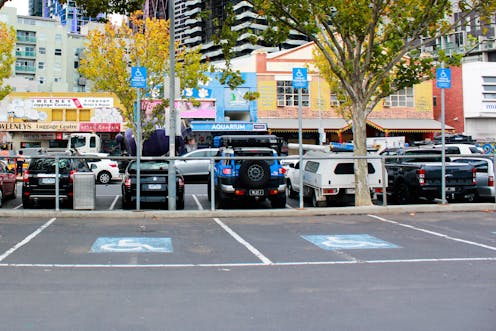
The need to cut the emissions driving climate change is urgent, but it’s proving hard to decarbonise road transport in Australia. Its share of the nation’s total greenhouse gas emissions doubled from 8% in 1990 to 16% in 2020. New vehicles sold in Australia have barely improved average emissions performance for the last decade or so.
The federal government publishes emission forecasts to 2035 – 15 years short of 2050, the net-zero target date. Our newly published study forecasts road transport emissions through to 2050. The estimated reduction by 2050, 35–45% of pre-COVID levels in 2019, falls well short of what’s needed.
Our findings highlight three obstacles to achieving net zero. These are: Australia’s delay in switching to electric vehicles; growing sales of large, heavy vehicles such as SUVs and utes; and uncertainties about hydrogen as a fuel, especially for freight transport. These findings point to policy actions that could get road transport much closer to net zero.
How was this worked out?
Emissions and energy use vary from vehicle to vehicle, so reliable forecasting requires a detailed breakdown of the on-road fleet. Our study used the Australian Fleet Model and the net zero vehicle emission model (n0vem).
The study focused on so-called well-to-wheel emissions from fuel production, distribution and use while driving. These activities account for about 75–85% of vehicle emissions. (Life-cycle assessment estimates “cradle-to-grave” emissions, including vehicle manufacture and disposal.)
Working with European Union colleagues, our emissions simulation drew on an updated EU scenario (EU-27) showing the changes in the EU vehicle fleet needed to meet the latest (proposed) CO₂ targets. Our study assumed Australia will be ten years behind the EU across all vehicle classes.
We further modified the scenario to properly reflect Australian conditions. For instance, the EU has a much higher proportion of plug-in hybrid vehicles than Australia, where buyers are now bypassing them for wholly electric vehicles.
Energy use is shifting, but too slowly
Using this modified scenario, the simulation produces a forecast fall in total wheel-to-wheel emissions from Australian transport from 104 billion tonnes (Mt) in 2018 to 55-65Mt in 2050. Within the range of this 35–45% reduction, the outcome depends largely on the balance of renewable and fossil-fuel energy used to produce hydrogen.
The modelling nonetheless predicts a large shift in energy use in road transport in 2050, as 2019 was basically 100% fossil fuels.
The on-road energy efficiency of battery electric vehicles is roughly twice that of fuel cell electric (hydrogen) vehicles and roughly three times that of fossil-fuelled vehicles of similar type.
The modelling results make this clear. In 2050, battery electric vehicles account for about 70% of total travel, but 25% of on-road energy use and only about 10% of total emissions.
In contrast, fossil-fuelled vehicles account for about 25% of total travel in 2050, 60% of energy use and 75-85% of emissions. That’s even allowing for expected efficiency improvements.
This means the shift to a mostly electric fleet by 2050 plus the use of hydrogen is predicted to fall short of what’s needed to get to net zero. It will require aggressive new policies to increase the uptake of electric vehicles across all classes.
Lighter vehicles make a big difference
But that is not the whole story. One neglected issue is the growing proportion of big, heavy passenger vehicles (SUVs, utes). This trend is very noticeable in Australia. The laws of physics mean heavier vehicles need much more energy and fuel per kilometre of driving, and so produce more emissions.
Currently, a large diesel SUV typically emits a kilogram of CO₂ for every 3 kilometres of driving, compared to 15km for a light electric vehicle and 200 kilometres for an e-bike. An average electric vehicle currently emits 1kg of CO₂ every 7km.
This distance is expected to be around 60km in 2050, when renewables power the electricity grid. A lightweight electric car will more than double the distance to 125km per kilogram of CO₂. Reducing vehicle weights and optimising energy efficiency in transport will be essential to meet emission targets.
The study modelled the impacts of lightweighting passenger vehicles while keeping buses and commercial vehicles the same. If Australians had driven only small cars in 2019 for personal use, total road transport emissions would have been about 15% lower.
The reduction in emissions from simply shifting to smaller cars is similar to emissions from domestic aviation and domestic shipping combined. Importantly, lightweighting cuts emissions for all kinds of vehicles.
The uncertainties about hydrogen
Fuel cell electric vehicles using hydrogen account for only a few percent of all travel, but most will likely be large trucks. As a result, in our scenarios, they use a little over 10% of total on-road energy and produce 5-20% of total emissions, depending on the energy source used for hydrogen production and distribution.
The modified EU scenario includes a significant uptake of hydrogen vehicles by 2050. That’s by no means guaranteed.
The uptake in Australia has been negligible to date. That’s due to costs (vehicle and fuel), the need for new hydrogen fuel infrastructure, less mature technology (compared to battery electric vehicles) and limited vehicle availability. Unresolved aspects of hydrogen in transport include lower energy efficiency, the need for clean water, uncertainty about leakage, fuel-cell durability and value for consumers.
How do we get back on track?
Our study suggests Australia is on track to miss the net-zero target for 2050 mainly because of the large proportions of fossil-fuelled vehicles and large and heavy passenger vehicles.
These two aspects could become targets for new policies such as public information campaigns, tax incentives for small, light vehicles, bans on selling fossil fuel vehicles and programs to scrap them. Other options to cut emissions include measures to reduce travel demand, optimise freight logistics and shift travel to public transport, to name a few.
The study confirms the scale of the challenge of decarbonising road transport. Australia will need “all hands on deck” – government, industry and consumers – to achieve net zero in 2050.
Robin Smit is the founder and director at Transport Energy/Emission Research Pty Ltd (TER) and an Adjunct Associate Professor at University of Technology Sydney.
This article was originally published on The Conversation. Read the original article.







